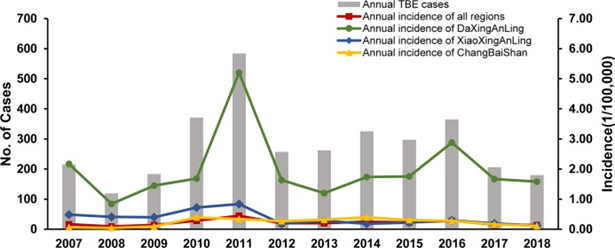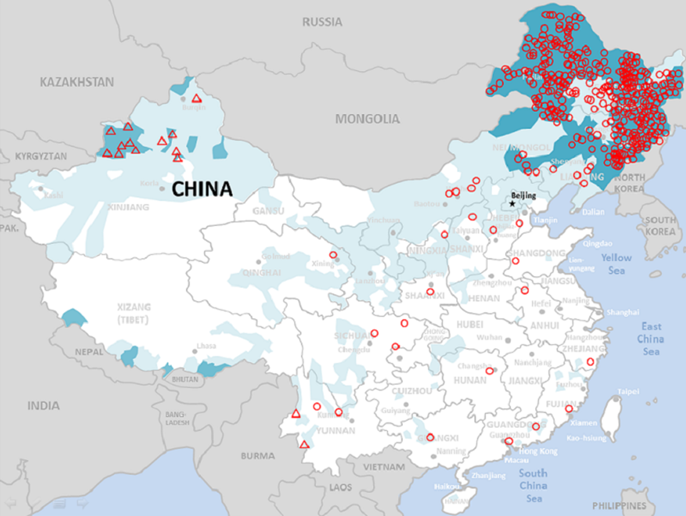Junfeng Yang and Heinz-Josef Schmitt
ECDC risk status: endemic
(last edited: date 01.03.2024)
History and current situation
Tick-borne encephalitis (TBE) is an endemic disease in some regions of northern China. The first TBE patients were reported in 1943 and TBE virus (TBEV) was isolated from brain tissues of two patients in 1944 by Japanese military scientists1 as well as from patients and ticks (I. persulcatus and Haemaphysalis concinna) in 1952 by Chinese researchers.2
In China, the Far Eastern (TBEV-FE) subtype is the endemic subtype which has been isolated from the 3 major endemic regions (northeastern China, western China and south-western China). It is mainly transmitted by Ixodes persulcatus.3 No European (TBEV-Eu), and Siberian (TBEV-Sib) subtypes were isolated to date according to our knowledge. Recently, Himalayan (Him-TBEV) subtype has been identified in wild rodents in Qinghai-Tibet Plateao in China.4
TBE patients are mainly reported from the epicenter: northeastern China, including Inner Mongolia Autonomous Region (Daxing’an Mountains), Heilongjiang Province (Xiaoxing’an Mountains) and Jilin Province (Changbai Mountains). Patients are also reported from another important epidemic area, the Tianshan Mountains and the Altai Mountains of the Xinjiang Autonomous Region5 as well as from other areas which were not considered to be endemic in the past (Figure 3). Cases may be missed as TBE is not a notifiable disease in China, especially in regions with lower TBE incidences, due to a lack of awareness among both physicians and the population and also due to a local lack of availability of serological testing.
The incidence of TBE decreased in China during the 1980s. However, it has been rising since 2008, as noted by disease control and prevention sectors and local hospitals.5 Case numbers remained stable in recent years.6 TBE patients before the 1980s were mainly forest workers, however, it has been reported that changes in the occupation / type of “exposure risk” occurred among TBE patients ever since and in particular since the late 1990s with 70%-95% of the most recent patients being non-forest working farmers, housewives, domestic workers, students, or anyone with any occupation who entered the endemic forest areas.7 Cases among tourists may be underreported, considering that the Chinese “TBE-epicenters” are also tourist resorts, and probably fewer protection measures are applied by tourists.
Overview of TBE in China
| Table 1: TBE in China | |
|---|---|
| Viral subtypes isolated | Far Eastern TBEV subtype1 |
| Reservoir animals | Mice and insectivorous animals; migratory birds; lagomorphs, goats 8 |
| Infected tick species (%) | I. persulcatus, however TBEV has also been isolated from H. concinna, H. japonica, Dermacentor silvarum, and I. ovatus7 |
| Dairy product transmission | Not known |
| Case definition used by authorities | Clinical case: symptoms (such as acute fever, headache, vomiting and/or typical central nervous system symptoms) + exposure in forests during spring or summer, or a tick bite history; Laboratory-confirmed case: clinical case + confirmed by laboratory serological tests (increased anti-TBEV IgG and IgM or ≥4-fold increase in specific antibody to TBEV between acute and convalescent serum samples) or PCR test positive for TBEV RNA if necessary9 |
| Type of reporting | Mandatory in Heilongjiang Province. Clinical TBE cases have been reported to the Chinese Information System for Diseases Control and Prevention (CISDCP) by the majority of provinces since 2002, such as Heilongjiang, Inner Mongolia Autonomous Region, Jilin, and Liaoning. No data publicly available 5 |
| Other TBE-surveillance | Detection of TBE virus in ticks have been conducted in endemic areas sporadically 10,11 |
| Special clinical features | Biphasic disease not reported from China. Different symptoms among patients with different disease severities; in the early 1950s, CFR of TBE in the northeastern forest areas was over 25%, but since the 1980s it has decreased to around 8%. Long-lasting sequelae of TBE are common, almost one-third of the patients in the 1952 outbreak had paralysis in the neck muscles or the shoulder muscles. Recently the complications of TBE over a ten-year period was reported to be 16.6% (90/542)12-15 |
| Licensed vaccines | TaiSenBao produced in China with Sen-Zhang strain as seed strain in PHK cell (Changchun Institute of Bio-product) 16 |
| Vaccination recommendations | Residence in endemic areas, travelers to endemic areas, with no reimbursement 17 |
| Vaccine uptake | NA |
| National Reference center for TBE | Chinese Center for Disease Prevention and Control / http://ivdc.chinacdc.cn/ |
| Additional relevant information | Seropositivity in the population: 19.7% in southwestern China; 35.4% in northwestern China; 0-10.9%, 0-9.8% and 7.6% in northeastern China 8 |
Figure 1: TBE case numbers and incidence in China, 2007 to 20186
As opportunities for TBE-diagnostics (serology) are limited, and as there is no mandatory reporting of TBE in China, the approximate 300 – 400 documented cases in China each year since 2007 are probably just the tip of the iceberg

Click the image above to enlarge

Click the image above to enlarge
Red Triangles: Confirmed TBEV foci in Xinjiang and Yunnan
Intensity of blue color: Reflects the probability of an area to be endemic for TBEV, dark blue = 100%, light blue = lower probabilities based on various environmental and climate criteria as published by Sun et al. 2017
Contact
Junfeng Yang
Junfeng.yang@pfizer.com
Authors
Junfeng Yang, Heinz-Josef Schmitt
Citation
Yang J, Schmitt HJ. TBE in China. Chapter 13. In: Dobler G, Erber W, Bröker M, Chitimia-Dobler L, Schmitt HJ, eds. The TBE Book. 7th ed. Singapore: Global Health Press; 2024. doi:10.33442/26613980_13-6-7
References
- Liu YJ, Jiang YT, Guo CS, Guan BP. Epidemiological characteristics of tick borne encephalitis natural foci in Jilin. Zhongguo Ren Min Jie Fang Jun Jun Shi Yi Xue Ke Xue Yuan Yuan Kan (Bulletin of the Academy of Military Medical Sciences) [in Chinese]. 1979;3:109-20.
- Yin DM, Liu RZ. Review on the control of forest encephalitis in the forest areas of north-east China. Zhonghua Liu Xing Bing Xue Za Zhi (Chinese Journal of Epidemiology) [in Chinese]. 2000;21:387-9.
- Bi WM, Deng HP, Bu XY. Regionalisation of natural foci of forest encephalitis. Shou Du Shi Fan Da Xue Xue Bao (Journal of Capital Normal University: Natural Science Edition) [in Chinese]. 1997;18:100-7.
- Dai X, Shang G, Lu S, Yang J, Xu J. A new subtype of eastern tick-borne encephalitis virus discovered in Qinghai-Tibet Plateau, China. Emerg Microbes Infect. 2018;7(1):74. doi: 10.1038/s41426-018-0081-6. PMID: 29691370; PMCID: PMC5915441.
- Sun RX, Lai SJ, Yang Y, et al. Mapping the distribution of tick-borne encephalitis in mainland China. Ticks Tick Borne Dis 2017(8)631–639
- Chen X, Li F, Yin Q, et al. Epidemiology of tick-borne encephalitis in China, 2007- 2018. PLoS One. 2019; 14(12):e0226712. doi: 10.1371/journal.pone.0226712. PMID: 31877145; PMCID: PMC6932775.
- Xing Y, Schmitt HJ, Arguedas A, et al. Tick-borne encephalitis in China: A review of epidemiology and vaccines. Vaccine. 2017;35(9):1227-1237.
- Huang WL, Hou ZL, Zi DY, Gong ZD, Lei YM, Mi ZQ, et al. Investigation of the Russian Spring-Summer Encephalitis virus in Yunnan province. Zhongguo Yu Fang Shou Yi Xue Bao (Chinese Journal of Preventive Veterinary Medicine) [in Chinese]. 2001;23:231-3.
- The Ministry of Health ofPeople’s Republic of China. Diagnostic Criteria of Occupational Forest Encephalitis (2002) (in Chinese). Available at: http://www.nhc.gov.cn/wjw/pyl/201212/34564.shtml (accessable on 29 Feb. 2024)
- Wang D, Ji HW, Wang ZD, et al. Isolation and Identification of Forest Encephalitis Virus Carried by Ticks in Part of Northeast China [J]. Chin. J. Prev. Vet [in Chinese]. 2021.DOI:10.16303/j.cnki.1005-4545.2021.03.10.
- Wang XY, Sun ZD, Suo JN,et al. Survey on the Distribution of Ticks and the Carriage Situation of Tick Borne Encephalitis Virus in Heilongjiang Province [J]. China Public Health Management [in Chinese]. 2020,36(5):750-752.DOI:10.19568/j.cnki.23-1318.2020.05.039.
- Liu YJ, Jiang YT, Guo CS, Guan BP. Epidemiological characteristics of tick borne encephalitis natural foci in Jilin. Zhongguo Ren Min Jie Fang Jun Jun Shi Yi Xue Ke Xue Yuan Yuan Kan (Bulletin of the Academy of Military Medical Sciences) [in Chinese]. 1979;3:109-20.
- Yin DM, Liu RZ. Review on the control of forest encephalitis in the forest areas of north-east China. Zhonghua Liu Xing Bing Xue Za Zhi (Chinese Journal of Epidemiology) [in Chinese]. 2000;21:387-9.
- Li H. Analysis of 90 cases of disability as the sequela of forest encephalitis. Zhongguo Lin Chuang Kang Fu (Chinese Journal of Clinical Rehabilitation) [in Chinese]. 2002;6:374.
- Zhang DH, Zhang ZX, Wang YM, Wang DH. Trends of forest encephalitis endemic in Heilongjiang. Ji Bing Jian Ce [Disease Surveillance] [in Chinese]. 2000;15:57-8.
- Changchun Institute of Bio-product (Chinese). https://www.ccbio.net/publicity/show-45.html (accessable on 29 Feb. 2024)
- Label of Tick borne encephalitis vaccine (Chinese). https://wenku.baidu.com/view/22151e19b8d528ea81c758f5f61fb7360b4c2bad.html?_wkts_=1709193206519&bdQuery=%E6%A3%AE%E6%9E%97%E8%84%91%E7%82%8E%E7%96%AB%E8%8B%97+%E8%AF%B4%E6%98%8E%E4%B9%A6&needWelcomeRecommand=1 (accessable on 29 Feb. 2024)
- Zhang GL, Liu R, Sun X, Zheng Y, Liu XM, Zhao Y, et al. Investigation on the endemic foci of tick-borne encephalitis virus in Xiaerxili Natural Reserve, Xinjiang. Zhonghua Liu Xing Bing Xue Za Zhi (Chinese Journal of Epidemiology) [in Chinese]. 2013;34:438-42.
- Cai ZL, Lu ZX, Hu LM, Zhao ZL, Jin XT, He YY. Epidemiology survey of Russian Spring Summer encephalitis in the northeast area, China. Wei Sheng Wu Xue Za Zhi (Journal of Microbiology) [in Chinese]. 1996;16:19-22.
- Zhang ZQ, Wu YM, Feng L, Wang HJ, Wang LQ, Liu GP, et al. A serological survey of forest encephalitis in northeast of China. Shenyang Bu Dui Yi Yao (Shenyang Army Medical Journal) [in Chinese]. 2006;19:112-3.
- Guo Y. Serological survey of forest encephalitis in Milin, Tibet. Zhong Wai Jian Kang Wen Zhai (World Health Digest) [in Chinese]. 2010;7:9-10.
